"Having a Ball With Chemistry"
National Chemistry Week
October 19-25, 2008
The following online exhibit is based on a physical exhibit developed by Wilson Library in conjunction with the W.T. Schrenk Society during the 2008 National Chemistry Week (October 19-25, 2008). The 2008 National Chemistry Week theme was "Having a Ball with Chemistry: The Chemistry of Sports."
National Chemistry Week (NCW) is a community-based program of the Office of Community Activities of the American Chemical Society. Many people watched the Olympics, and this year's National Chemistry Week celebrates the chemistry of sports. This year's theme unites ACS local sections, businesses, schools, and individuals in communicating how chemistry used to better the quality of sports, sports safety, and the importance of hydration and good nutrition for athletes of all kinds.
Chemistry is a growing field with various specialties, which covers everything from medicine to plastics! Wilson library has numerous resources for individuals interested in going into chemistry, including career guidebooks, trade magazines, and even online books.
Missouri S&T students have numerous ways to get involved in chemistry including the W.T. Schrenk Society, Alpha Chi Sigma, and American Institute of Chemical Engineers.
NOTE: Some of the links are to subscription resources and only accessible to the Missouri S&T community or on-campus.
| Mole Day National Chemistry Week also contains Mole Day, which falls on October 23rd. A mole is a unit of measurement used in chemistry to describe the number of discrete units instead of using mass or volume. The number of units per mole is 6.02214 x 1023, hence 10/23 is Mole Day! You can learn more about Mole Day at the National Mole Day Foundation and the following National Public Radio program titled Chemistry Lovers Celebrate Mole Day. |  ACS Mole |
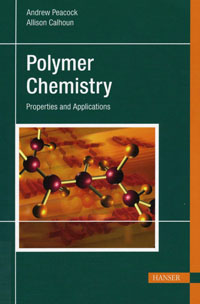 | Polymers "Polymers are very large molecules made by covalently binding many smaller molecules. The word polymer is derived from the Greek poly (many) and meros (part). The size of polymer molecules imparts many interesting and useful properties not shared by low molecular weigh materials. Polymers are the fundamental materials of plastics, rubbers, and most fibers, and surface coatings and adhesives, and as such are essential to modern society. Also, many important constitutes of living organisms, e.g., proteins and cellulose, are biopolymers." (Rosen, 2005, p. 1345) Rosen, S. (2005). polymers. in G. Considine (Ed.), Van Nostrand's Encyclopedia of Chemistry (5th ed.). Hoboken, NJ: Wiley. |
| Polymers are widely used in sporting equipment such as balls, protective equipment, and high performance apparel. Two articles on the subject appeared in the Journal of Chemical Education by Dr. Scott E. McKay: McKay, S., Robbins, T. and Cole, R. (2008). Modern sport and chemistry: What a golf fanatic should know. Journal of Chemical Education, 85(10), 1319-1322. Giffin, G., Boone, S., Cole, R., & McKay, S. (2002). Modern sport and chemistry: What a chemically aware sports fanatic should know. Journal of Chemical Education, 79(7), 813-819. |
| "Sports engineering is an interdisciplinary subject, which encompasses and integrates not only sports science and engineering but also much broader issues that are of paramount importance to developing and implementing new sports technology. The engineering of sport: Research, development and innovation aims to provide an overview of the state-of-the-art in sports technology." (Subic & Haake, 2000, p. viii) Subic, A., & Haake, S. (Eds.). (2000). The engineering of sport: research, development and innovation . Oxford: Blackwell Science. | 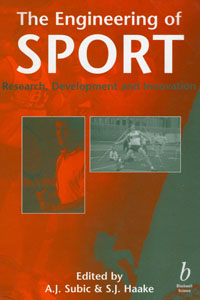 |
| Olympics - In addition to athletic talent and excellence, the Olympics is often a showcase of high-tech materials for apparel, equipment, and even construction materials. Michael McCoy's article titled "Faster, Higher, Stronger" describes some of the newer materials (all polymers) being utilized at the 2008 Summer Olympics in Beijing, China. The cover story of the February 4, 2002 issue of Chemical & Engineering News was "Olympic Science" and discussed a wide range of materials - mainly polymers - used during the 2002 Winter Olympics in Salt Lake City, Utah. McCoy, M. (2008). Faster, Higher, Stronger. Chemical & Engineering News, 80(5), 10. Jacoby, M. (2002). Olympic Science. Chemical & Engineering News, 80(5), 29-32. |
| Olympiadane - "[T]he first molecular compound consisting of a linear array of five interlocked rings." (Amabilino et al., 1994, p.1287). It looks like the five interlocking Olympic rings, hence the name Olympiadane. The synthesis was described in the journal Angewandte Chemie and also reported in the New York Times. Amabilino,D., Ashton, P., Reder, A., Spencer, N., & Stoddart, J. (1994). Olympiadane. Angewandte Chemie, 33(12), 1286-1290. Browne, M. (1994, August 30). Chemist's make rings of interlocked atoms, a clue to life's origin. New York Times, p. C1. |
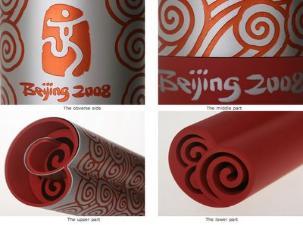 | Olympic Torch - The 2008 Olympic torch was designed by Lenovo and China Aerospace Science and Industry Corporation. It is sleek and modern with a 'Cloud of Promise' design to reflect the association of clouds in the Chinese culture. Polished aluminum-magnesium alloy, it stands 28 x 2 x 1.5 inches and weighs 2.2 pounds. More than thirty specialists and experts, in areas like chemistry and engineering, joined forces to create this important symbol for the Olympic Games. |
| Source: The Beijing Organizing Committee for the Games of the XXIX Olympiad. Retrieved October 20, 2008, from http://torchrelay.beijing2008.cn/en/image/torchdesign/ | |
| Visual Elements Periodic Table - The exhibit also included a framed poster of the Visual Elements Periodic Table, which is a collaborative effort between Glasgow artist Murray Robertson and the Royal Society of Chemistry. "...Murray Robertson has produced a striking new representation of the chemical elements drawing on the on the symbolism that surrounds them from the commonplace, nickel in baked beans, to the mythological, Oppenheimer's invocation of Shiva as the genie behind the destructive power of of the element Plutonium. The images work on a number of levels. As artwork they are wonderfully executed and provide a feast for the eyes. Such striking representations of the elements bring an appreciation of the complexity of the chemical reality which underlies the universe, and promotes the subject as being exciting and full of potential." (Watson, n.d., p. 1) Many of the images that Robertson created are intuitive. For example, aluminum is represented by aluminum aircraft body with a crinkled aluminum foil background. Other images, like gallium, are less intuitive. Gallium is represented by a cockerel with a map of France. This makes sense if you know that gallium was isolated in France and the cockerel is one of France's cultural symbols. Please visit the following URL for more information about the images, elements, and project: http://www.rsc.org/chemsoc/visualelements/ Watson, D. (n.d.). A interpretation of the table of elements . Retrieved October 20, 2008 from http://www.rsc.org/chemsoc/visualelements/pages/intro.html |
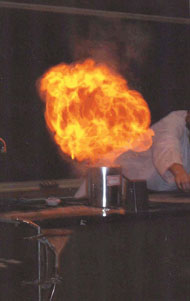 2006 Magic Show | W.T. Schrenk Society - This exhibit was a collaborative project between the W.T. Schrenk Society and the Wilson Library. The Schrenk Society is the official Missouri S&T chemistry club, open to anyone with an interest in chemistry. The club meets once a week and invites a variety of speakers to learn about research that is going on and opportunities available around campus. The club participates in numerous events. One of the society's big events is the "Magic Show" in the spring for local elementary school students. You can learn more about the Schrenk Society by visiting http://web.mst.edu/~schrenk/. |
| Chemistry as a Profession - The American Chemical Society (ACS) is the largest scientific organization in the world. ACS members are mostly chemists, chemical engineers, and other professionals who work in chemistry and chemistry-related jobs. ACS maintains a webpage with career related information and profiles of chemists at the following URL: http://portal.acs.org/portal/PublicWebSite/careers/whatchemistsdo/index.htm "Contrary to what some people think, an education and background in chemistry prepares you for much more than just a laboratory career. The broad science education, logical and analytical thinking, research method, and other professional skills are of value to a wide variety of employers, and are essential for a plethora of positions." Source: Back cover of Nontraditional careers for chemists: New formulas in chemistry. A review of Nontraditional careers for chemists: New formulas in chemistry was published in Chemical & Engineering News in February 2007: Borchardt, J. (2007). Career choices: Book outlines alternative career paths for chemists. Chemical & Engineering News, 85(7). 82-84. | 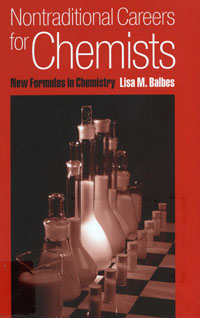 |
Exhibit prepared by David Hubbard

Follow University Libraries